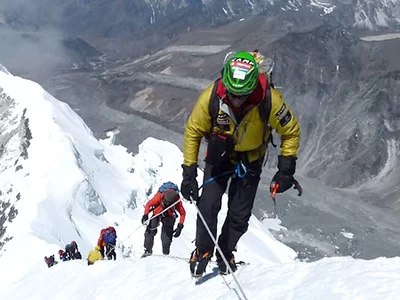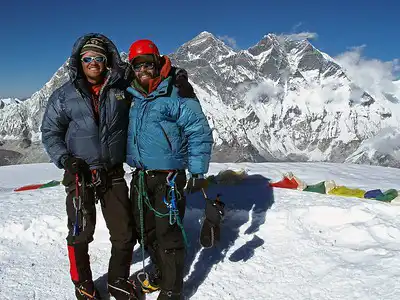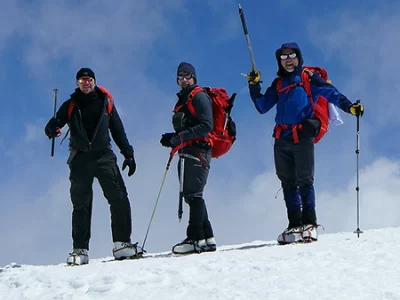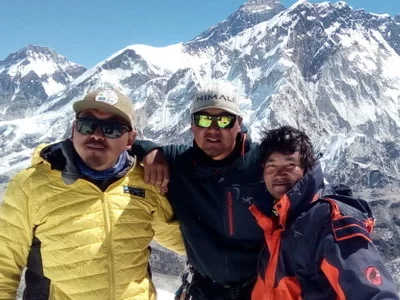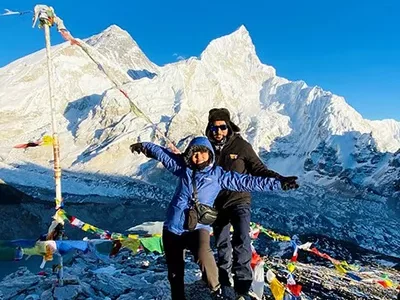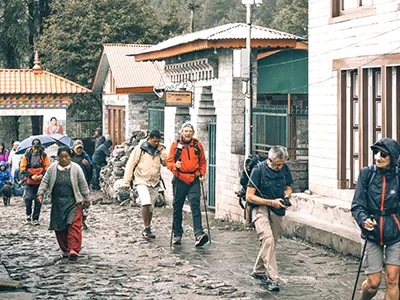The Island Peak, called Imja Tse, towers high in the Everest area of Nepal, drawing climbers from all across the globe. At a fantastic height of 6,189 meters (20,305 feet), this peak is a prototype for trekking and mountaineering. Climbers see breathtaking views of the Himalayas while passing through Sherpa settlements, dense woods, and alpine grazing lands. The Island Peak Climbing Itinerary offers a balanced experience with acclimatization stops and technical climbing sections, making it both rewarding and challenging.
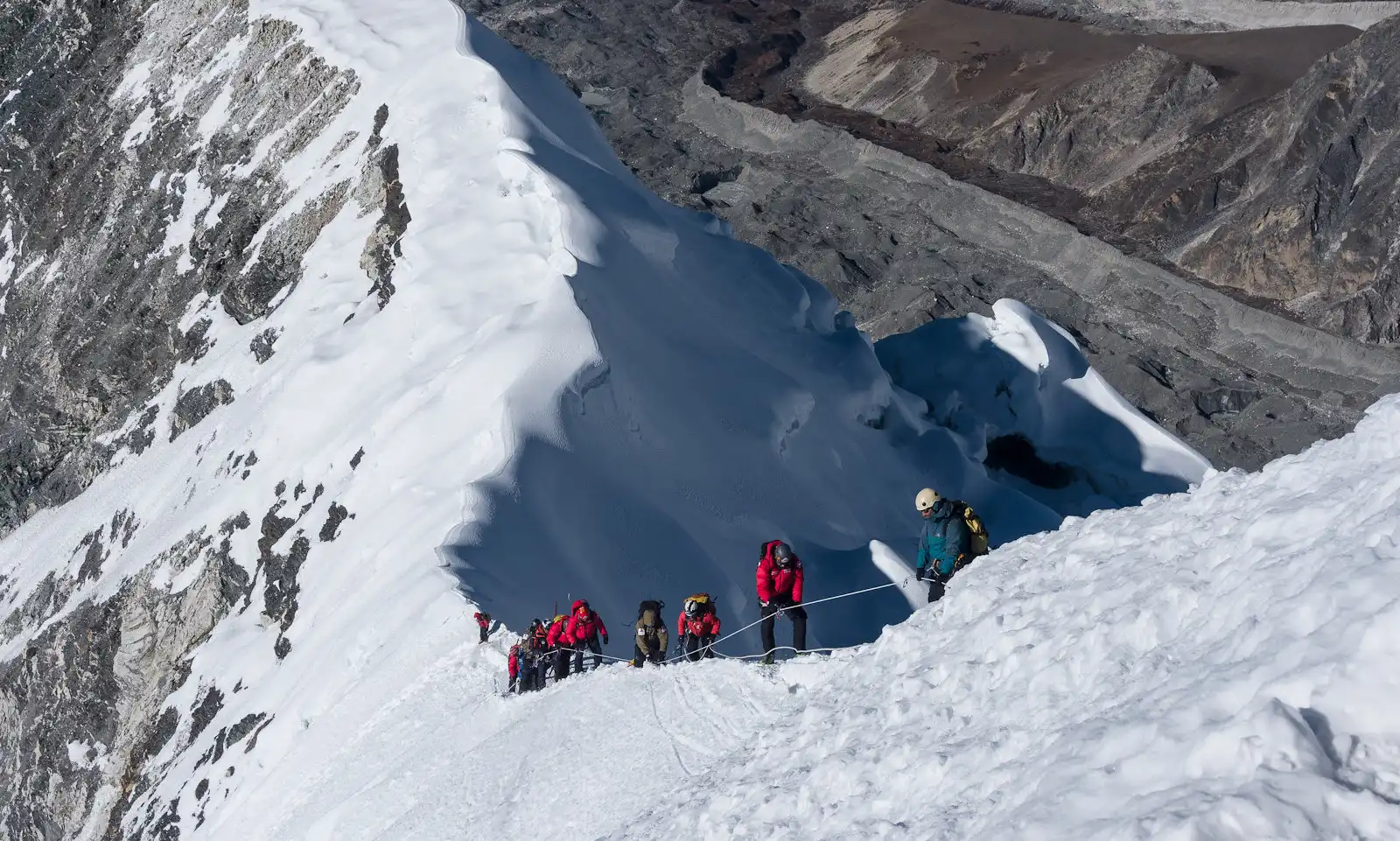
Island Peak’s popularity comes from its accessibility to trekkers with moderate experience while providing an exciting summit. Many climbers combine it with the Everest Base Camp trek for proper acclimatization before attempting the climb. In the Khumbu region, Island Peak offers breathtaking views of towering Himalayan peaks like Lhotse, Makalu, and Ama Dablam. The climb is technical but manageable, making it a great introduction to high-altitude mountaineering.
Who Should Attempt Island Peak Climbing?
- Trekkers with high-altitude experience: Previous trekking above 4,000 meters is advantageous.
- Climbers with basic mountaineering knowledge: I recommend becoming familiar with crampons, ropes, and ice axes.
- Fit and healthy individuals: Strong physical fitness and endurance are essential.
- Adventure seekers looking for a manageable challenge: The climb offers most climbers a technical but achievable ascent.
Island Peak Climbing with EBC Trek
Ama Dablam Expedition
Mera Peak Climbing
Island Peak Climbing Itinerary: A Detailed Day-by-Day Guide
Day 1: Arrival in Kathmandu (1,300m/4,264ft)
Upon arrival at Tribhuvan International Airport, a Peregrine Treks & Tours representative will greet you and transfer you to your hotel. After check-in, you can relax at the hotel or explore the lively streets of Kathmandu.
Later in the evening, meet with your guide to review the Island Peak Climbing Itinerary, discuss critical details, and make final preparations for your trek.
You will stay at The Everest Hotel, a luxurious option offering comfortable rooms and excellent facilities. This will ensure a restful start to your adventure.
Day 2: Island Peak Climbing Preparation & Kathmandu Sightseeing (1,350m)
The day begins with thoroughly reviewing the climbing gear and final preparations for your Island Peak Climbing Itinerary. Your guide will ensure that all equipment is in order, and you’ll double-check that you have everything needed for the adventure’s trekking and climbing portions. Preparing well for the challenging days ahead is crucial.
Later, you’ll begin a cultural sightseeing tour of Kathmandu’s UNESCO World Heritage Sites. You will visit the holy Pashupatinath Temple, an important place for Hindu pilgrimage, and then move on to Boudhanath Stupa, one of the largest Buddhist stupas on earth.
Finally, you will visit Swayambhunath, also called Monkey Temple, to get a bird s-eye view of the city. This day merges cultural exploration with acclimatization so that your mind and body are ready for the upcoming exhilarating climb.
Day 3: Fly to Lukla & Trek to Phakding (2,652m/8,700ft)
You’ll begin the day with a breathtaking 40-minute flight to Lukla, soaring over the snow-capped peaks of the Himalayas. After landing in Lukla (2,860m), the trek officially starts as you trek towards Phakding.
The 3-4 hour hike passes through scenic Sherpa villages, vibrant rhododendron forests, and sacred stupas. This relatively easy trek offers the chance to adjust to the higher altitude as you take in the local culture and natural beauty.
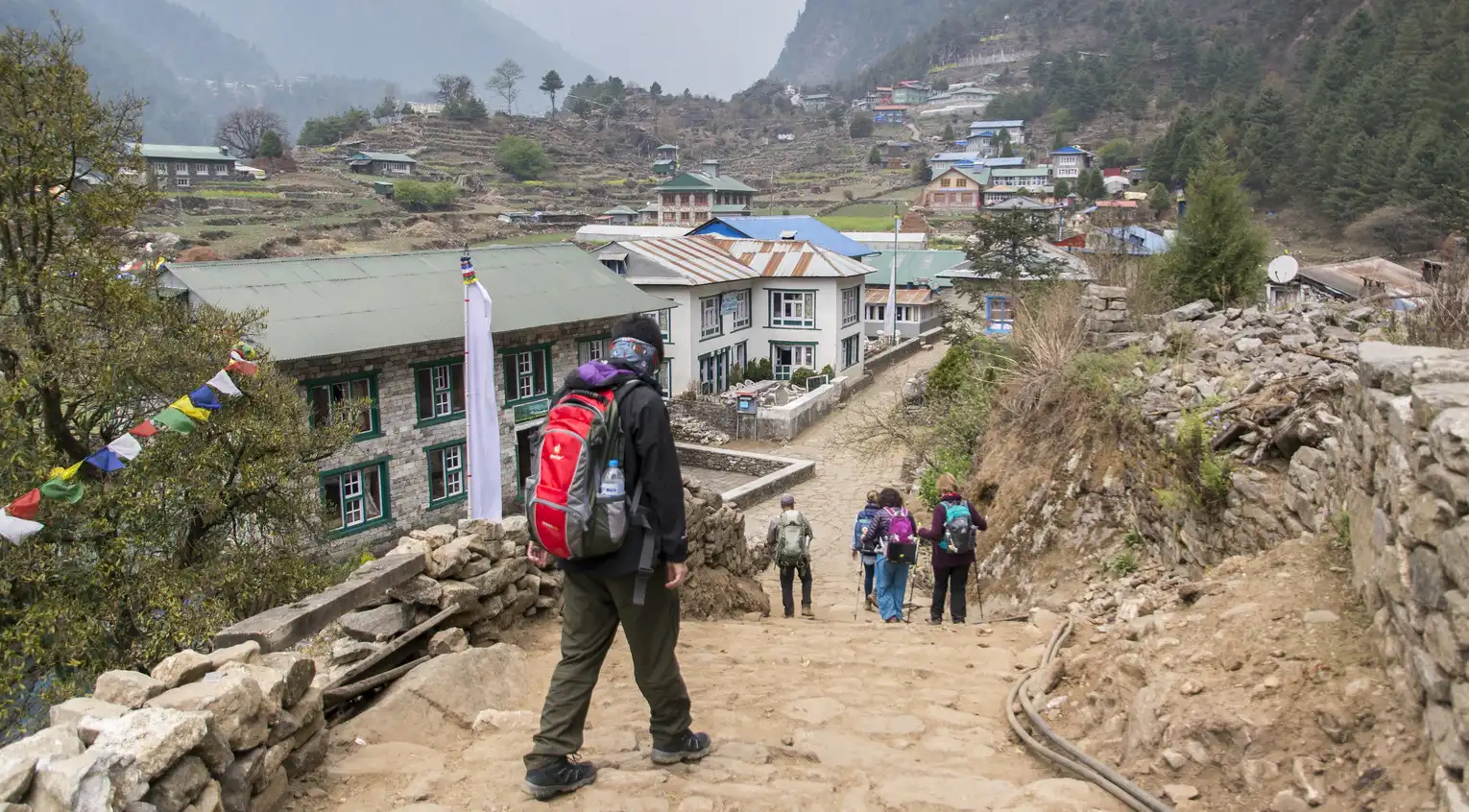
On this initial leg of your Island Peak Climbing Itinerary, you’ll experience the charm of the Khumbu region. As you walk, the wind will flutter prayer flags around you, and you’ll pass beautifully carved mani stones. The calm village of Phakding, located on the banks of the Dudh Koshi River, is an ideal overnight stop to help your body acclimate, ensuring you’re well-prepared for the more strenuous days ahead.
Day 4: Trek to Namche Bazaar (3,440m/11,283ft)
The trek from Phakding to Namche Bazaar presents a more demanding challenge as you navigate alpine landscapes. This 5-6 hour hike includes several thrilling crossings over suspension bridges and takes you through pine forests and cascading waterfalls.
The trail passes into Sagarmatha National Park, where you will have your trekking permits verified. You’ll see the first glimpses of Mount Everest’s towering peak along the way.
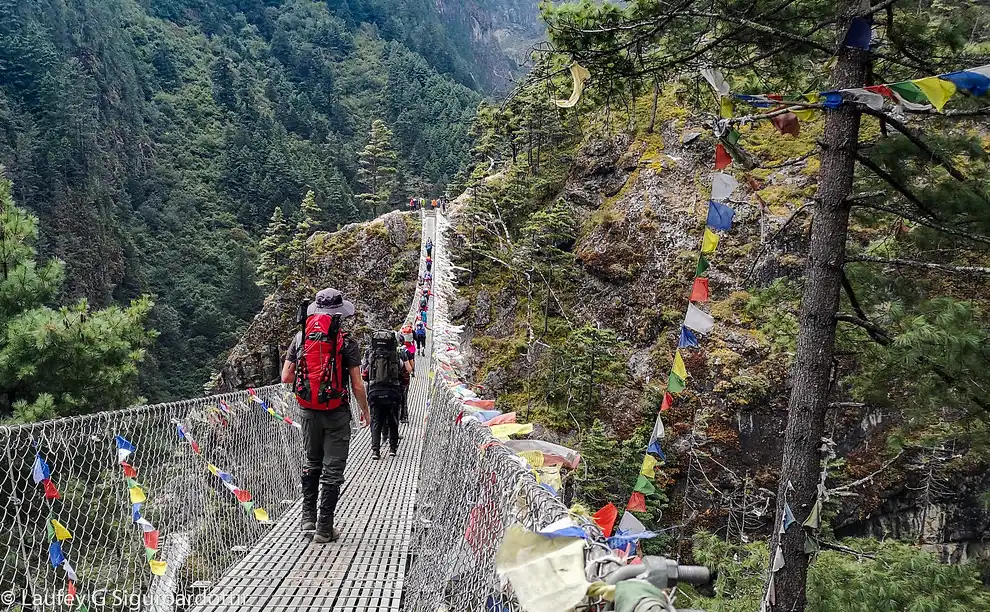
As you near Namche Bazaar, the final part of the trail involves a steep climb. The effort is rewarded with incredible panoramic views of the surrounding mountains, making the challenging ascent well worth it.
At 3440 meters, Namche Bazaar is a lively Sherpa town famously known as the gateway to Everest. It has numerous shops, cafes, internet services for trekkers and the ever-present Sherpa culture that defines this Himalayan town. Here, one can easily find a place to recuperate without difficulty.
Day 5: Acclimatization Day in Namche Bazaar (3,440m/11,283ft)
You will spend Day 5 acclimatizing in Namche Bazaar to help your body adjust to the increasing altitude. This day is essential for allowing you to adapt before continuing to higher elevations. A 2-3 hour hike to the famous Everest View Hotel offers sweeping views of Everest, Lhotse, and Ama Dablam without putting excessive strain on your body. This gentle hike assists with acclimatization while allowing you to savor the breathtaking Himalayan panorama.
Namche Bazar is a hub of exploration itself. You can do many things, like walk along vivid markets, learn more about the Sherpa culture from the Sherpa museum, or relax in the incredible altitude.
One must acclimatize at this height because it decreases the chances of altitude sickness and prepares oneself adequately before attempting to climb higher heights in the days ahead. The rest day and short hikes will help you physically and mentally prepare for the challenges ahead in your Island Peak climbing itinerary.
Lobuche Peak Climbing
Everest Base Camp Trek
Luxury Everest Base Camp Trek
Day 6: Trek to Tengboche (3,870m/12,694ft)
The trek to Tengboche takes about 5-6 hours and leads through stunning landscapes with views of Everest, Lhotse, and Ama Dablam. The trail begins with a gentle descent, passing through rhododendron and pine forests and crossing several suspension bridges over the Dudh Koshi River. As you ascend toward Tengboche, the terrain becomes steeper, but the reward is the breathtaking panoramic vistas of the Himalayan range.
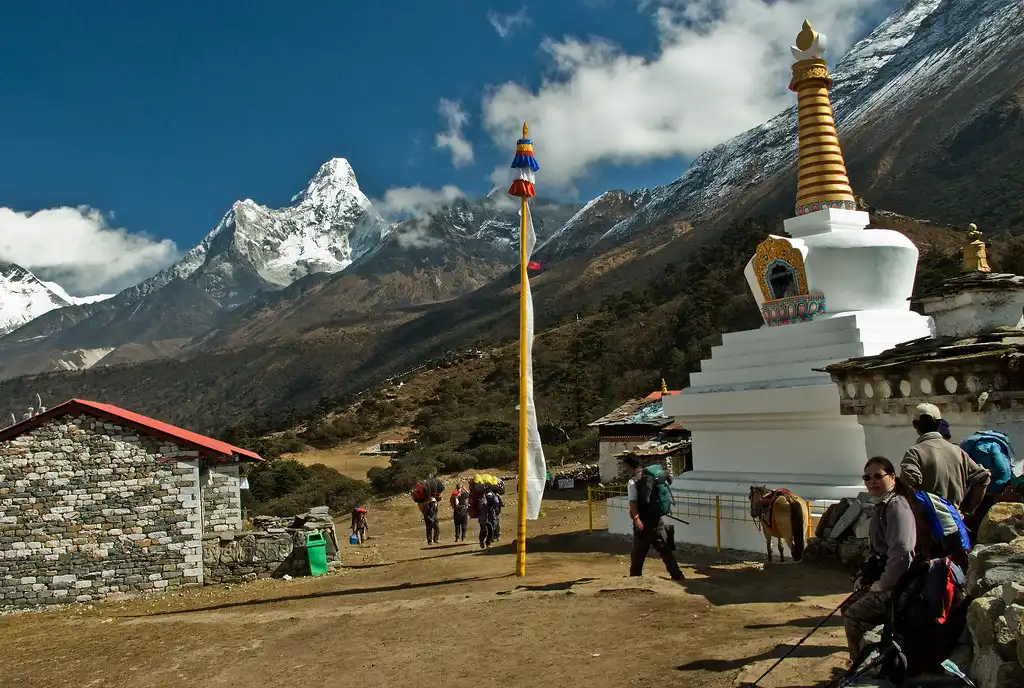
Upon arrival in Tengboche, you’ll visit the famous Tengboche Monastery, the largest in the region. This spiritual site, set against the backdrop of snow-capped peaks, offers a moment of peace and reflection amid your adventure. Tengboche is also a significant cultural stop on the trek, where you can witness Buddhist rituals and soak in the tranquil atmosphere. After exploring the monastery, you’ll rest for the night at a nearby teahouse, preparing for the next day’s ascent.
Day 7: Trek to Pheriche (4,200m/13,776ft)
The trek from Tengboche to Pheriche begins with a descent through the dense forests to Deboche, followed by a gradual ascent towards Pangboche. As you pass through Pangboche, known for its famous monastery, you’ll get closer to the open, high-altitude valley of Pheriche. The route takes you through alpine meadows and yak herder camps, allowing you to experience the remote beauty of the Khumbu region.
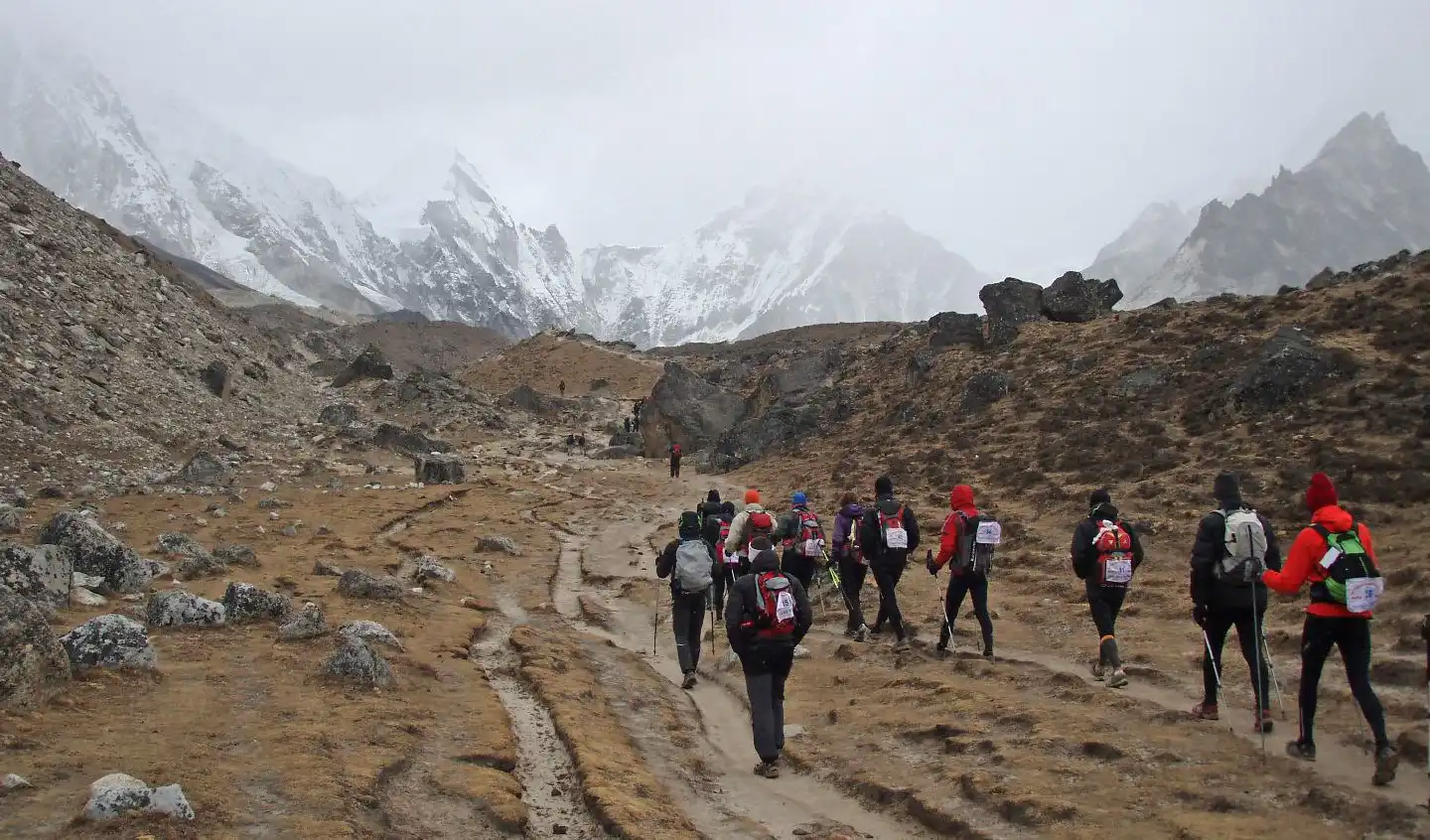
Pheriche, situated at 4,200 meters, is a critical acclimatization stop for trekkers heading towards higher altitudes. The broad valley here offers a sense of tranquility, with stunning mountain views all around. You’ll spend the night in a comfortable lodge, resting and preparing for the higher elevations you’ll face in the coming days. The Himalayan Rescue Association stationed in Pheriche offers an excellent opportunity to learn more about the region.
Day 8: Trek to Lobuche (4,930m/16,170ft)
The day’s trek starts with a relatively easy walk through the wide valley of Pheriche. You’ll gradually ascend towards Dukla Pass, passing through a landscape with yak grazing fields. As you approach Dukla, the trail becomes steeper, leading to the memorials dedicated to climbers who lost their lives in their Everest expeditions. The sight of these memorials, set against a dramatic mountain backdrop, serves as a poignant reminder of the challenges of high-altitude climbing.
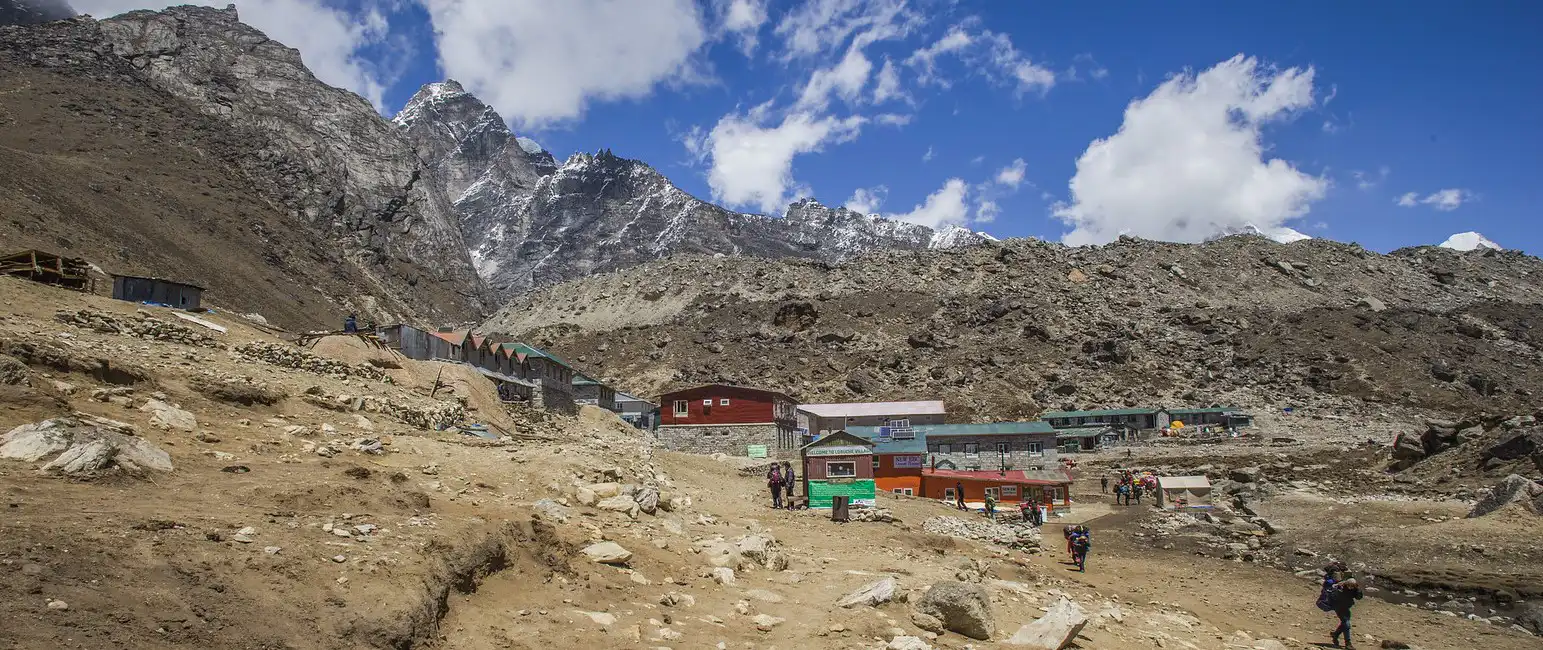
After spending time at the memorials, you’ll continue your trek along the Khumbu Glacier. The path towards Lobuche becomes rocky and barren as you gain elevation, with stunning views of towering peaks like Pumori and Nuptse guiding your way. Upon reaching Lobuche, you’ll settle in for the night, resting for the highly anticipated trek to Everest Base Camp the following day.
Day 9: Trek to Gorak Shep & Visit Everest Base Camp (5,364m/17,594ft)
Your trek to Gorak Shep, the final settlement before Everest Base Camp, takes about 3-4 hours over a rugged, glacial terrain. The trail offers continuous views of some of the world’s highest peaks, making it one of the most exciting parts of the trek. Upon reaching Gorak Shep, you’ll take a break for lunch before heading out to Everest Base Camp. This iconic location is filled with the colorful tents of climbers, offering a firsthand glimpse of expedition life.
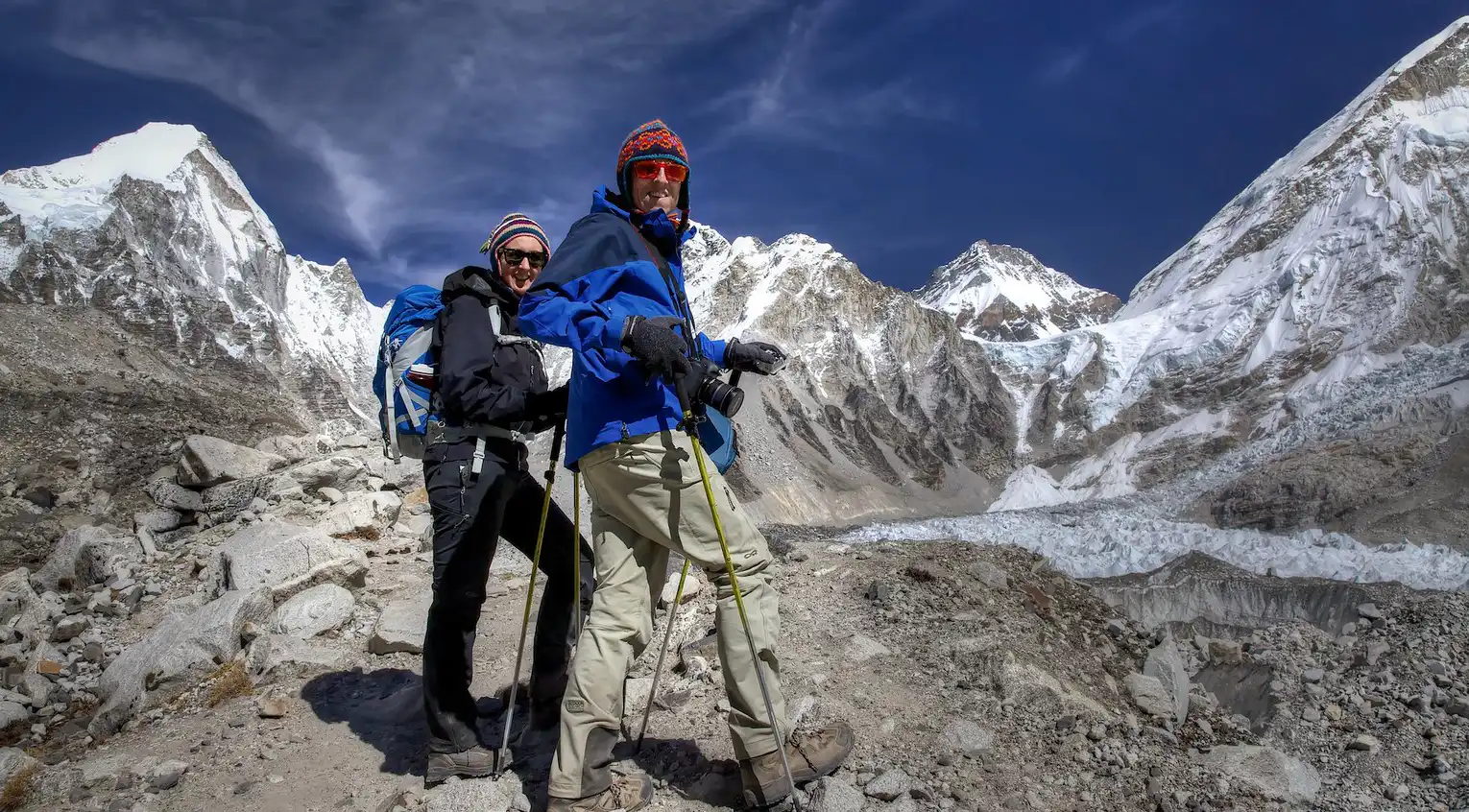
The trek from Gorak Shep to Everest Base Camp involves navigating the Khumbu Glacier and its icefalls. Although the terrain presents challenges, the experience of standing at the base of Mount Everest remains unforgettable. You’ll take time to explore the base camp, take photos, and absorb the magnitude of the setting before returning to Gorak Shep for the night. This day marks a significant achievement in your Island Peak Climbing Itinerary and provides an inspiring view of Everest’s grandeur.
Day 10: Climb Kala Patthar and Trek to Dingboche
Trekking begins quickly on the summit of Kala Patthar at six in the morning. The sunrise above Mount Everest rewards one with stunning sights of her neighboring mountains like Lhotse and Nubtse, which tower over the rest. After breakfast in Gorak Shep, continue descending, passing through familiar places until you reach Dingboche, where you will spend the night.
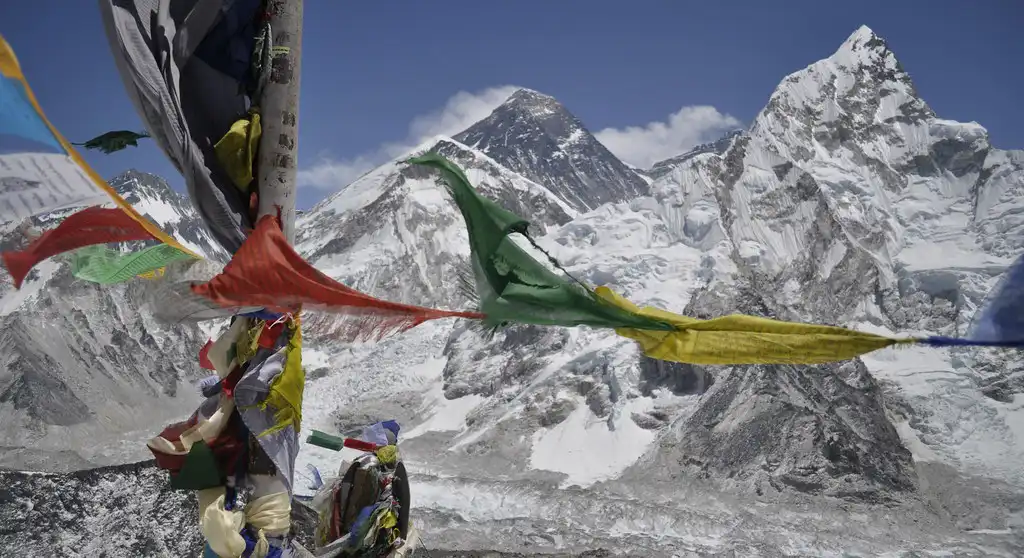
This day offers a visual highlight with the stunning sunrise and marks the descent from the higher altitudes, which is a welcome relief for your body. Dingboche, nestled in a serene valley, provides a comfortable environment to rest and prepare for the next phase of your trek, heading toward Island Peak.
Day 11: Trek to Chhukung (4,730m)
The trek from Dingboche to Chhukung is a shorter 3-hour hike, but the elevation gain challenges your endurance. The trail leads through wide, open valleys surrounded by snow-capped peaks. As you approach Chhukung, striking views of Ama Dablam and other towering mountains will greet you.
Upon reaching Chhukung, your guide will brief you on the technical aspects of the upcoming Island Peak climb. You will dedicate the afternoon to checking your gear and preparing for the summit push. Proper preparation at this crucial moment in your Island Peak Climbing itinerary will ensure a safer and more enjoyable ascent.
Day 12: Trek to Island Peak Base Camp (5,200m)
The trek from Chhukung to Island Peak Base Camp takes about 4 hours, and the scenery only becomes more spectacular as you approach the high mountain passes. You’ll trek through rugged terrain, crossing moraines and ridges, with expansive views of glaciers and towering peaks like Lhotse. This section of the trek helps acclimatize your body to the altitude, making the climb safer.
Upon arriving at Island Peak Base Camp, you’ll set up camp and prepare for the summit attempt. Your guide will give a detailed briefing about the route, the technical challenges, and the equipment you’ll be using. This day is essential for getting familiar with the surroundings and mentally preparing for the demanding climb ahead.
Day 13: Pre-climb Training at Island Peak Base Camp
You will focus entirely on pre-climb training and acclimatization on this day. Under the guidance of your experienced trek leader, you will practice using essential climbing equipment like ropes, harnesses, and crampons. The training will also include techniques for ladder crossings and handling the more technical parts of the climb, such as glacier navigation and ascending fixed ropes.
This day sharpens your climbing skills and helps your body adjust further to the altitude. Spending extra time at Base Camp enhances your readiness for the final push to the summit of Island Peak. With your gear checked and your confidence boosted, you’ll be well-prepared for summit day.
Day 14: Summit Island Peak (6,189m) and Return to Base Camp
Summit day begins in the early hours, usually around 2 AM, as you start the challenging ascent under the cover of darkness. You’ll navigate steep snow slopes and ice ridges using fixed ropes and crampons. The climb is physically demanding but incredibly rewarding as you reach the summit of Island Peak (6,189m), where panoramic views of Everest, Lhotse, and Makalu greet you.
After taking in the breathtaking scenery at the summit, you’ll begin your descent back to Island Peak Base Camp. Although the descent can be tiring, the sense of accomplishment from summiting makes this day a highlight of the Island Peak Climbing Itinerary. You’ll spend the night at Base Camp, resting after your successful climb.
Day 15: Trek to Pangboche (3,985m)
After celebrating your successful summit of Island Peak, the descent to Pangboche begins. The trail takes you through familiar landscapes, offering a refreshing sense of accomplishment as you leave behind the high altitudes. You’ll walk past Chhukung and Dingboche before reaching Pangboche, a peaceful village in Ama Dablam’s shadow. The trek today will be easier as you descend, allowing you to fully appreciate the scenery without the altitude challenges.
In Pangboche, the beautiful mountain views and the soothing sounds of the Dudh Koshi River will surround you. This village is also home to one of the region’s oldest monasteries, providing an opportunity to learn more about Sherpa culture. You will spend the evening reflecting on your climbing, enjoying a well-earned rest, and preparing to return to Namche Bazaar the next day.
Day 16: Trek to Namche Bazaar (3,440m)
The trek to Namche Bazaar takes you back through the familiar route, descending to lower altitudes with each step. As you retrace your path, the trail becomes more manageable, offering time to relax and reflect on the incredible achievement of reaching the Island Peak summit. You’ll cross suspension bridges, walk through rhododendron forests, and enjoy panoramic views of the Himalayan giants one last time.
Upon reaching Namche Bazaar, you’ll feel the energy of the bustling Sherpa town once again. This stop lets you relax, enjoy comfort, and explore the vibrant market stalls. Namche offers everything from hot showers to souvenir shopping, allowing you to unwind and celebrate with fellow trekkers after the climb’s challenges.
Day 17: Trek to Lukla (2,800m)
Your final day of trekking takes you from Namche Bazaar back to Lukla, where the adventure began. The trail is a mix of gentle descents and a few uphill stretches, passing through villages, forests, and alongside the Dudh Koshi River. This last trek offers a reflective moment as you bid farewell to the beautiful landscapes of the Everest region.
You will be able to relax and celebrate the successful conclusion of your staffing plan on Island Peak climbing during this period to go trekking at Lukla. This evening, make joyful memories as everyone shares their experiences, and rest assured knowing that you have conquered the most challenging phase of the trek.
Day 18: Fly to Kathmandu
Early in the morning, let’s fly to Kathmandu from Lukla, ending your trekking adventure with the last chance to see the high Himalayan Mountains by air on this flight. When you return to Kathmandu, you can go to the hotel, where you can either rest or tour the lively marketplaces and culture of the city.
Your trekking group and guides will arrange a farewell dinner in the evening. As you wrap up this adventure of a lifetime, celebrate the completion of your Island Peak climb, reflect on the incredible experiences you’ve shared, and enjoy Nepalese cuisine.
Day 19: Final Departure
On the final day of your Island Peak adventure, we will transfer you to Tribhuvan International Airport for your departure. As you prepare to leave, you’ll take unforgettable memories of the Himalayas, the warmth of the Sherpa people, and the sense of accomplishment from conquering Island Peak. Whether heading home or on to your next destination, this experience will remain a cherished chapter in your travels.
Best Time to Climb Island Peak
When planning your Island Peak Climbing Itinerary, choosing the right time is crucial for a safe and successful ascent. The best seasons for climbing Island Peak are Spring (March-May) and Autumn (September-November). These months offer stable weather conditions, clear skies, and moderate temperatures, making them ideal for high-altitude trekking and climbing.
In Spring, the trails come alive with blooming rhododendrons, while Autumn provides crisp air and stunning views of the Himalayas. The weather in these seasons is typically dry, reducing the risks associated with unpredictable rain or snowfall and ensuring excellent visibility. Additionally, the temperatures are more bearable, especially at higher elevations, making the climb more manageable.
Considerations for Winter and Monsoon Climbing
Climbing during Winter (December-February) and Monsoon (June-August) is possible but comes with added challenges. The temperature drops significantly in winter, especially at night, and heavy snow can make the ascent more difficult. Despite these challenges, some climbers enjoy the quieter trails and the solitude of fewer trekkers.
In contrast, it rains heavily during the rainy monsoon season, making the pathways slim and susceptible to mudslides in the lower parts. Also, cloud cover frequently prevents beautiful mountain scenery that is worth climbing. However, if one is daring enough, climbers can still climb during such low-season periods as long as he does their homework well.
Physical Fitness and Preparation for Island Peak Climbing
- Endurance Training: Building stamina is essential for high-altitude trekking. Focus on cardio exercises like running, cycling, and swimming to improve your cardiovascular system, as the trek involves long walking hours.
- Strength Training: Strengthen your legs, core, and upper body to carry gear and manage the demands of the trek. Squats, lunges, and core exercises are ideal.
- Acclimatization Practice: Hiking at high altitudes before your trek helps your body adapt to thinner air, reducing altitude sickness risks.
Essential Gear for Island Peak Climbing Itinerary
- Climbing Gear: Pack essential equipment such as crampons, harnesses, ice axes, and ropes. These tools are vital for safe ascent on steep, icy sections.
- Trekking Gear: Ensure you have sturdy boots, thermal layers, and a waterproof jacket to handle varying temperatures. Gloves and a woolen hat are also crucial.
- Camping Equipment: While most trekking companies provide tents, sleeping bags, and cooking gear, verify this beforehand to avoid unnecessary packing. Trekking operators often supply high-altitude sleeping bags and portable stoves.
Island Peak Climbing Cost
The Island Peak Climbing Itinerary typically costs between $2,500 and $3,000. This price includes permits, accommodation, meals, guide services, and internal flights. Before booking, confirm what the package covers. Costs can vary based on the trekking company, group size, and additional services like gear rental or extra acclimatization days.
Permits and Regulations
Climbers need three essential permits for Island Peak:
- Island Peak Climbing Permit: Issued by the Nepal Mountaineering Association.
- Sagarmatha National Park Entry Permit: Required for access to the park.
- TIMS Card (Trekkers’ Information Management System): Helps track trekkers for safety.
Accommodation and Meals
During the Island Peak Climbing Itinerary, trekkers stay in teahouses along the main trekking route. These lodges provide basic amenities, including warm beds and hot meals.
At Island Peak Base Camp, climbers switch to camping, where the trekking crew prepares meals. The food on the trek includes traditional Nepali dishes like dal bhat alongside international options. As you ascend, meal costs rise due to transportation challenges.
Challenges and Safety
Climbing Island Peak presents technical challenges, especially during the summit push, which requires fixed ropes and proper climbing gear. Altitude sickness is a significant concern, making proper acclimatization crucial. To mitigate risks, climbers should trek slowly, stay hydrated, and listen to their guide’s instructions. Carrying medication for altitude sickness is also recommended.
Conclusion
The Island Peak Climbing Itinerary rewards trekkers with breathtaking views of Everest, Lhotse, and Makalu, offering incredible achievement. Conquering this iconic trekking peak, combined with the cultural richness of the Everest region, makes this adventure both challenging and unforgettable.

